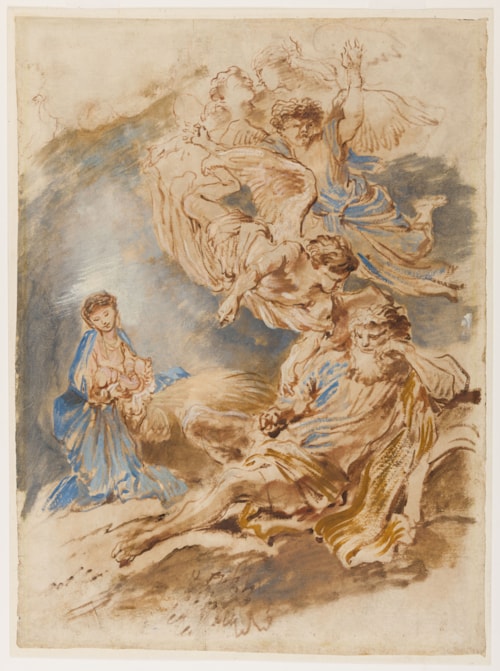
Giovanni Benedetto CASTIGLIONE
Genoa 1609 - Mantua 1664
Biography
Sometimes known as ‘il Grechetto’, the Genoese artist Giovanni Benedetto Castiglione received his training in the studio of Giovanni Battista Paggi and, following Paggi’s death in 1627, with Giovanni Andrea de’ Ferrari. He may also have studied with Anthony Van Dyck, who was in Genoa between 1621 and 1627, and the animal painter Sinibaldo Scorza, whose work seems to have had the most influence on the young artist. Like Scorza, he developed a particular penchant for animal paintings, landscapes, pastoral scenes and Old Testament subjects. He was also highly regarded as a portrait painter, although only a very few examples have been identified today. Castiglione’s earliest signed and dated painting was executed in 1633 in Rome, but he first established his reputation in his native city. For much of his career, he was regarded as one of the finest painters in Genoa, producing altarpieces and canvases for churches and palaces all over the city, and his fame eventually spread throughout Italy. In the later part of his career Castiglione began to produce paintings and drawings that were intensely religious in feeling.
Apart from working extensively in Genoa, Castiglione travelled widely and was active in Venice, Parma, Naples and Rome, where he worked for several years in the 1630s and again between about 1647 and 1651. From 1651 onwards he worked mostly in Mantua, where he was employed by the Gonzaga court, and where he died in 1664. As Jonathan Bober has summed up the artist’s career, ‘Castiglione was, beyond the quintessential Genoese artist, a genius of the highest order. He was not responsible for any of the basic languages of the Italian baroque, or even any of the major currents in the art of his native city. But by restless nature, genuine intellect, and seemingly boundless imagination, he attended to more styles, and synthesized them more thoroughly, than any other artist of the school, if not the entire seventeenth century.’ Despite not having many pupils or followers of note, apart from his brother Salvatore and son Francesco, as well as the Neapolitan painter Andrea de Leone, Castiglione’s influence on later Genoese painting was profound and long lasting. As another scholar has written, ‘Grechetto’s art is at the very core of the “decorative trend” of Genoese Baroque painting. Without him there would never have existed Gregorio de Ferrari, Domenico Piola, even Gaulli.’
Castiglione has always been better known for his extraordinary graphic output than his paintings. He was a prolific and spirited draughtsman, working mainly in pen and wash, and made numerous drawings not just as studies for painted compositions but as works of art in their own right. He was also a gifted printmaker, and may well be credited with the invention of the monotype process. As noted by James Byam Shaw, ‘[Castiglione] was something of a wild character, and there is wild grandeur in his style of painting, drawing, and etching.’ The largest surviving group of drawings and oil sketches by Castiglione, amounting to more than two hundred sheets, is today in the Royal Collection at Windsor Castle.



